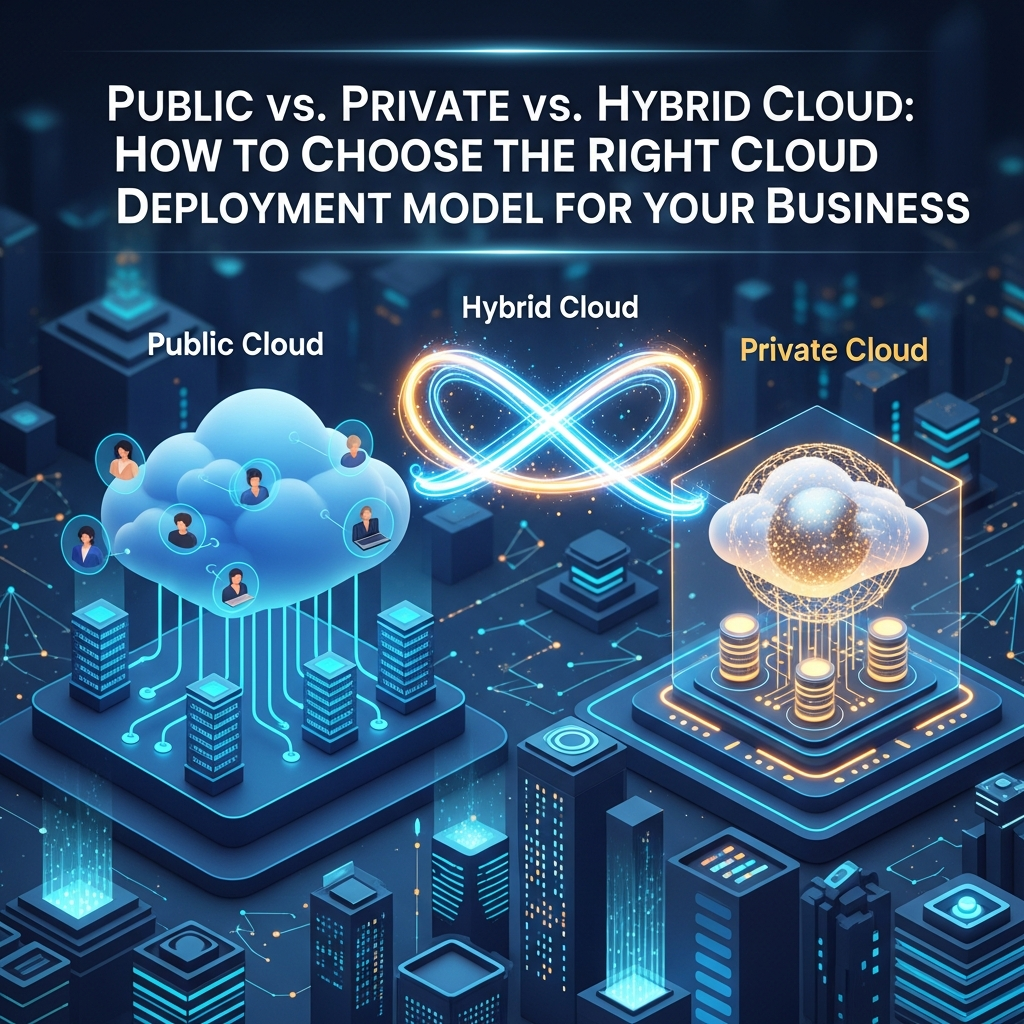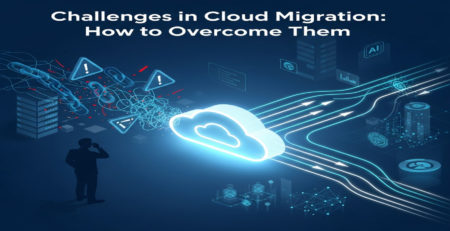Public vs Private vs Hybrid Cloud: How to Choose the Right Cloud Deployment Model for Your Business
DSSP2025-11-10T15:37:34+00:00Public vs. Private vs. Hybrid Cloud
INTRODUCTION
Let’s be honest the term cloud computing gets tossed around a lot. Everyone’s moving there, everyone’s transforming something, and every vendor seems to promise the same magic. But behind the buzzwords sits a real, practical question that keeps U.S. business leaders awake at night:
Should we go public vs private vs hybrid cloud?
It sounds simple until you’re the one making that call. Then it hits you this isn’t about data centers. It’s about how your business breathes. About who controls your information, how fast you can move, and how much risk you’re willing to take.So, let’s talk human to human not engineer to engineer. Because the truth is, every cloud model tells a story. And the right one tells yours.
What Is Public vs Private vs Hybrid Cloud?
Here’s the short version:
- Public cloud means renting power.
- Private cloud means owning it.
- Hybrid cloud means balancing both.
Now let’s slow that down.
Public Cloud — The Open Highway
Imagine renting a car instead of buying one. It’s faster, cheaper at first, and you can switch models whenever you want. That’s public cloud shared infrastructure managed by giants like AWS, Microsoft Azure, and Google Cloud.They handle the heavy lifting: hardware, maintenance, scaling, security patches. You just pay for what you use. Need 100 servers for a week? Done. Back to 10 next month? Also done.
Startups love it. Enterprises use it for agility and global reach. It’s where innovation happens fast.
A quick story:
A small digital retailer in Texas used AWS to launch a flash sale. Traffic exploded. Servers scaled up instantly. When the rush ended, everything shrank back. No lost sales, no all-nighters for IT.
That’s the public cloud — speed on demand.
Why teams go public:
- Instant scalability.
- No hardware investment.
- Global reach and reliability.
- Pay-as-you-go flexibility.
The trade-off: You don’t control everything. It’s secure but shared. Like renting in a gated community.
Private Cloud — The Quiet Mansion
Now picture owning your own house. You design every inch, choose every lock, and decide who gets the keys. That’s a private cloud.
It’s built just for you no neighbors, no sharing. You control the infrastructure, the security rules, the network. You decide how data moves and who touches it.This model shines in industries like healthcare, banking, and government, where data protection isn’t optional it’s survival.
Example:
A hospital chain in New York uses a private cloud to host patient records and imaging data. Every server is HIPAA-compliant. Auditors walk in and see airtight controls. Data never leaves the building.
Why leaders choose private:
- Total control over performance and access.
- Easier compliance with strict regulations.
- Stable, predictable costs.
- Custom-built to fit specific workloads.
Trade-off: It’s expensive upfront and slower to scale. But for mission-critical operations, that control is priceless.
Hybrid Cloud — The Smart Middle
And then there’s the middle ground hybrid cloud. It’s where you keep sensitive data in your private setup but run everything else in a public one.Hybrid is flexibility. It’s the model most large U.S. organizations are quietly moving toward because it gives them the best of both worlds control and speed.
Example:
A major bank uses private servers for transaction data but relies on Azure for its AI-based fraud detection tools. The two systems talk seamlessly. Security stays intact, innovation runs fast.
Why teams go hybrid:
- Flexibility to put workloads where they perform best.
- Cost optimization.
- Built-in resilience and backup.
- Smooth modernization path for legacy systems.
Trade-off: Integration complexity. But done right, it’s the future-proof route
Why Choosing the Right Cloud Model Matters
This isn’t just an IT call. It’s a business-defining decision.Because your cloud model shapes how fast you move, how safe you stay, and how much you spend.
Let’s break that down.
1️⃣ Cost and Control
The cloud directly impacts your bottom line.
Public is cheaper to start — no capital cost.
Private is predictable — fixed long-term expense.
Hybrid balances both — scale when needed, save when steady.
Companies that plan well see operational costs drop by up to 30% while gaining agility. The key isn’t which model you choose it’s how well you manage it.
2️⃣ Security and Compliance
Data breaches destroy trust. Regulations like HIPAA, SOC 2, and GDPR make compliance non-negotiable.Public clouds now have enterprise-grade security, but private and hybrid lets tailor policies and keep sensitive data isolated.Remember, compliance isn’t a checkbox. It’s a promise to your customers.
3️⃣ Speed and Agility
Business speed is survival. The faster you can build, test, and release, the more competitive you stay.Public cloud gives you speed. A private cloud gives you control. Hybrid gives you balance run fast where it’s safe, stay guarded where it’s critical.A hybrid setup lets teams experiment without risking compliance. That’s why enterprises use it for innovation sandboxes and pilot programs.
4️⃣ People and Productivity
The most overlooked benefit of cloud adoption? Happiness.
When tools just work, employees do too. Developers deploy quickly. Data scientists explore freely. Sales teams access insights instantly.When you remove friction, people create magic. And that’s what the right cloud environment does: it gives them space to breathe.

How to Choose the Right Cloud Deployment Model
Here’s the simple, people-first framework that U.S. companies use to decide.
Step 1: Define Your Purpose
Ask yourself, “What do we actually want?” Speed? Security? Cost efficiency? A mix?
- If your priority is speed and flexibility → Public Cloud.
- If compliance and control rule your world → Private Cloud.
- If you want balance → Hybrid Cloud.
Step 2: Know Your Workloads
Map where each system belongs.
- Front-end apps, websites → Public.
- Databases, financials → Private.
- Analytics, AI, and IoT → Hybrid.
Step 3: Understand Your Risk
If your brand depends on confidentiality, private or hybrid is safer.
If your goal is rapid experimentation, the public will save time.
Most leaders end up in a hybrid because it fits their real-world complexity.
Step 4: Evaluate Costs
Don’t look at the upfront cost alone.
Factor in data transfers, maintenance, compliance audits, and staffing.
Sometimes a more expensive setup saves more in the long run.
Step 5: Think Beyond Today
Your cloud needs will evolve.
AI, automation, and edge computing are changing the game.
Hybrid gives you the flexibility to integrate these new layers as they come.
When to Use Each Cloud Type
Let’s make it practical.
Public Cloud — When It Makes Sense
- You’re a fast-moving startup or digital-first business.
- You have seasonal traffic spikes.
- You want fast innovation with limited staff.
Perfect for: SaaS platforms, media, retail, mobile apps.
Private Cloud — When It’s Essential
- You handle personal or financial data.
- You work under strict regulatory frameworks.
- You need custom-built performance.
Perfect for: Healthcare, banking, defense, and government.
Hybrid Cloud — When It’s Inevitable
- You’re modernizing legacy systems gradually.
- You want agility but can’t compromise security.
- You need to handle AI, data analytics, or remote operations.
Perfect for: Large enterprises and global organizations

Real Stories from the U.S. Market
Capital One : Adopted a hybrid model AWS for customer-facing services, private for transaction systems.The result? Faster rollouts, fewer outages, stronger security posture.
Johnson & Johnson : Runs global R&D on a hybrid system connecting private servers to Azure AI. Researchers collaborate across continents, securely and efficiently.
The Mayo Clinic : Uses hybrid infrastructure to run AI-powered imaging analysis on Google Cloud while storing patient data privately. It’s saving lives by analyzing scans faster all while staying compliant.
These aren’t tech decisions; they’re human ones about trust, innovation, and responsibility.
Quick Comparison Chart
Feature | Public Cloud | Private Cloud | Hybrid Cloud |
Cost | Low upfront, flexible | High upfront, stable | Balanced |
Scalability | Unlimited | Limited | High |
Security | Shared | Dedicated | Customizable |
Compliance | Medium | High | High |
Control | Low | Full | Moderate |
Deployment Speed | Fast | Slow | Medium |
Ideal Users | Startups, SaaS | Regulated sectors | Enterprises modernizing |
.
The Future of Cloud Deployment
By 2026, over 75% of enterprises will run hybrid or multi-cloud environments.The question will shift from “Which cloud?” to “How do we connect them all?”
AI will automate scaling. Edge computing will bring data closer to users.Cloud orchestration tools will tie everything together seamlessly.
Hybrid will quietly become the new default, the invisible backbone of modern enterprise.The future of the cloud isn’t about where data lives. It’s about how fast it moves and how safely it moves with people at the center.
Conclusion:
So where does your story land?
Public gives you freedom.
Private gives you safety.
Hybrid gives you harmony.
There’s no universal “best.” Only what fits your mission.
Ask yourself three questions:
- Does this model help my team move faster?
- Does it protect my customers’ trust?
- Does it grow with me?
When your answers align, you’ve found your cloud sweet spot.
Because the cloud isn’t really about servers or code it’s about clarity.
It’s about giving people and businesses the power to adapt, create, and thrive without friction.And that, boss, is what real digital transformation feels like.







Leave a Reply